Contrast Bathing
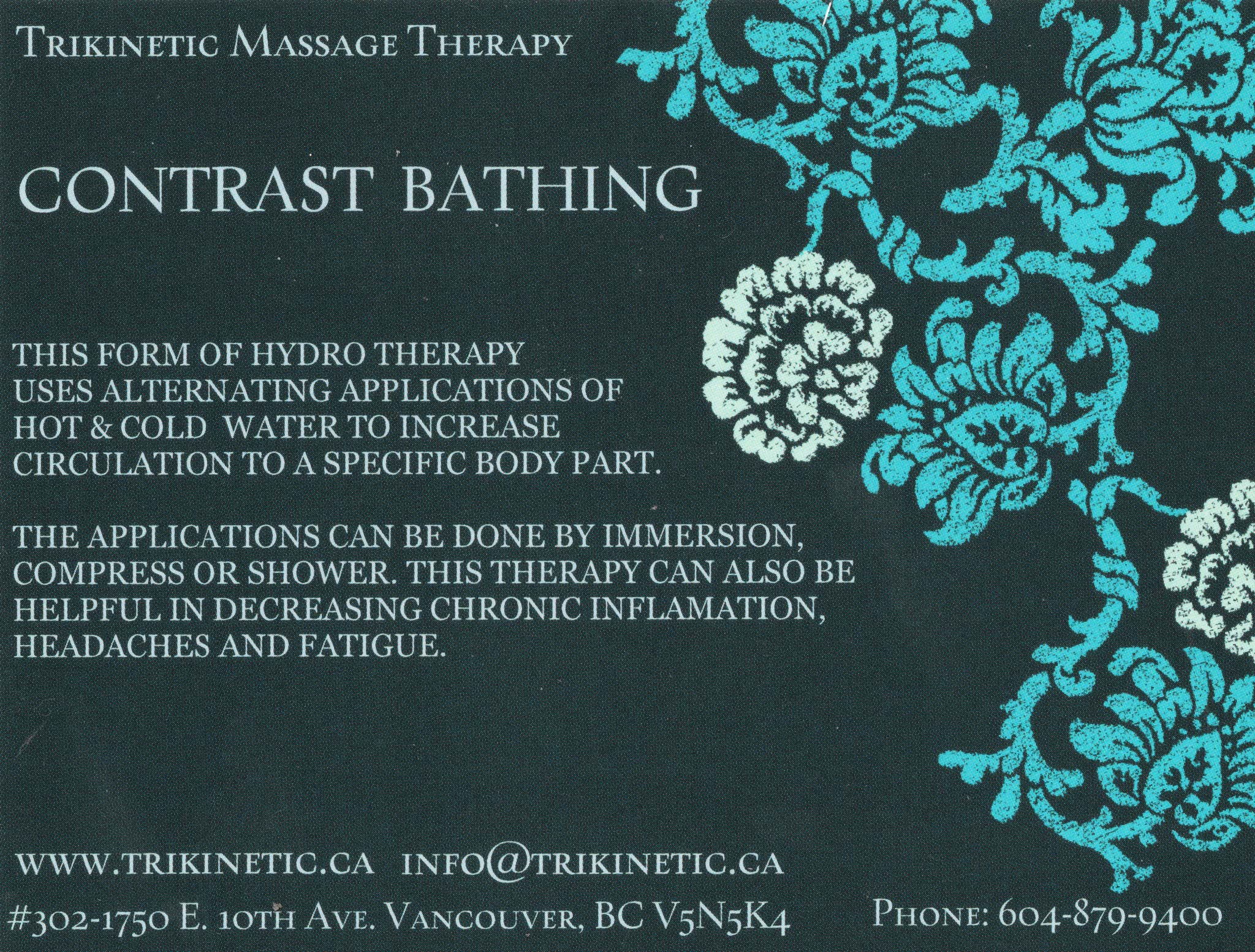
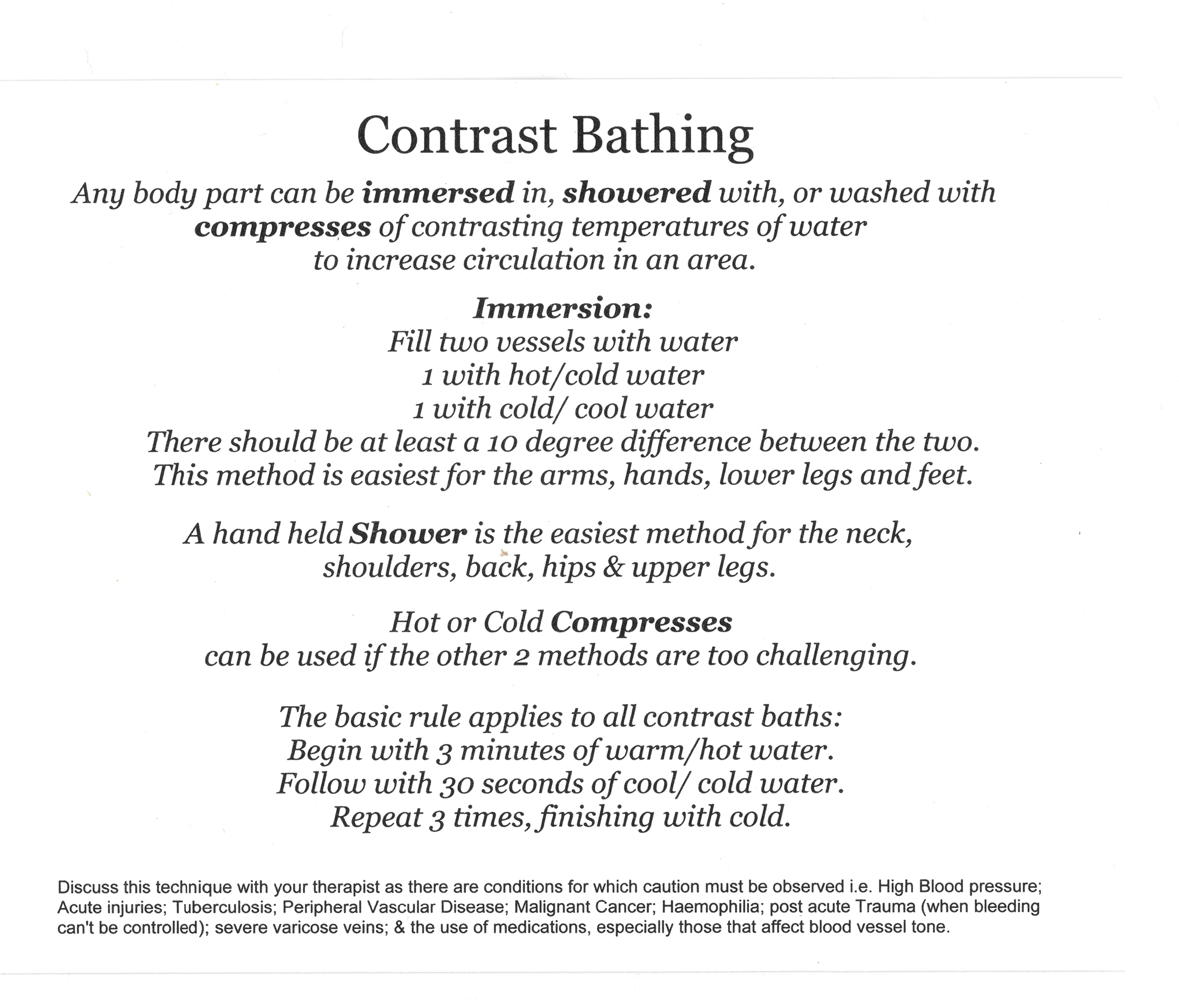
Craniosacral Massage Therapy
The craniosacral system refers to the environment in which your brain and spinal cord develops and functions.The bones of the skull, spine and sacrum all attach to membranes that enclose the cerebrospinal fluid. The cerebrospinal fluid creates a pulse, similar to the beat of your heart or the rhythm of your breath, and this can be used to aid healing.When using craniosacral therapy an RMT uses a gentle, hands-on method that tests and evaluates problems affecting this complex, core and highly important system. This technique is excellent for those recovering from injuries sustained due to a motor vehicle accident as these often create hyper-activity throughout the whole nervous system. Craniosacral therapy calms the whole system enough to enable healing to begin. Because of its gentle nature, this technique works well for areas of the body that are very sensitive to touch.
Epsom Salt Baths
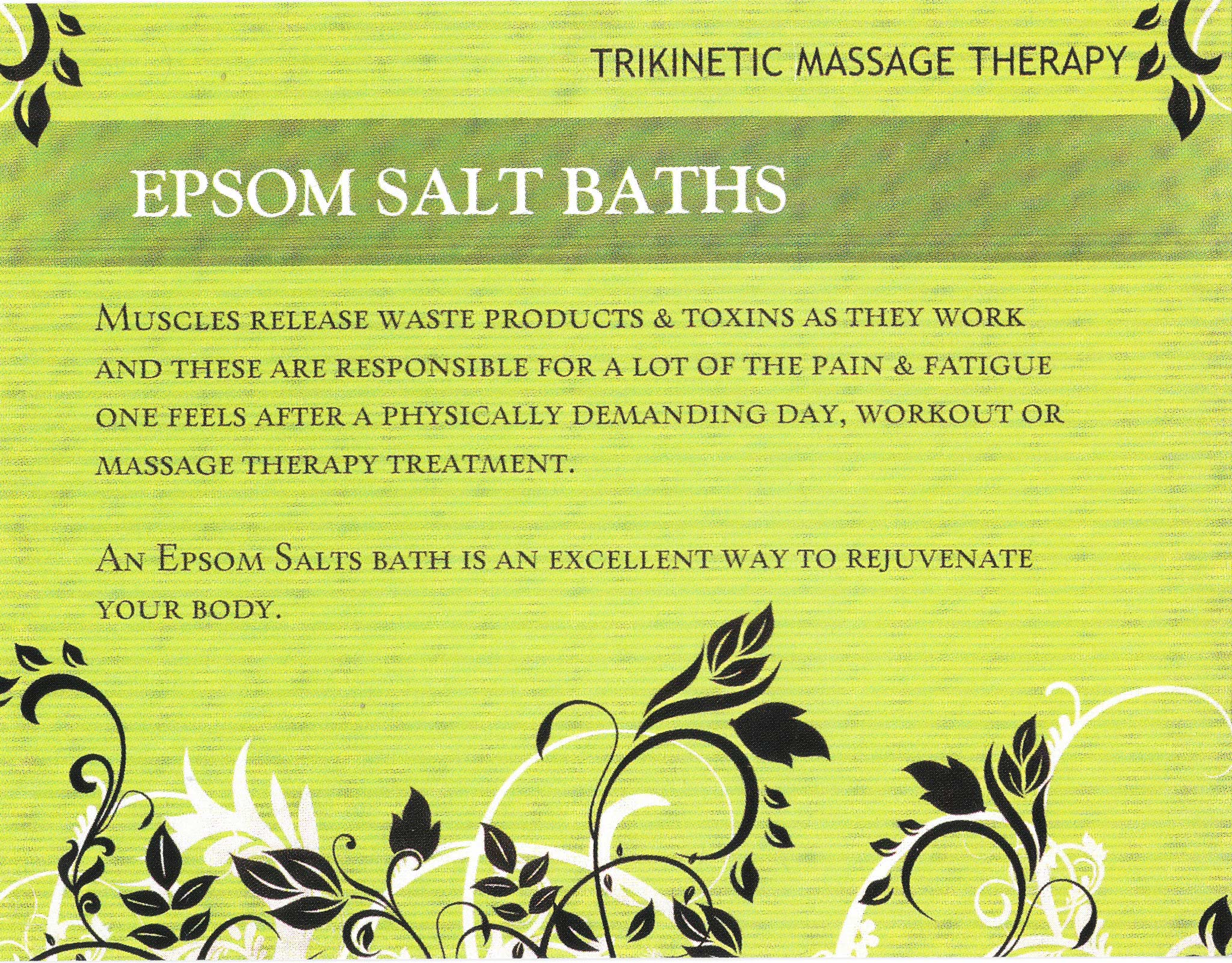
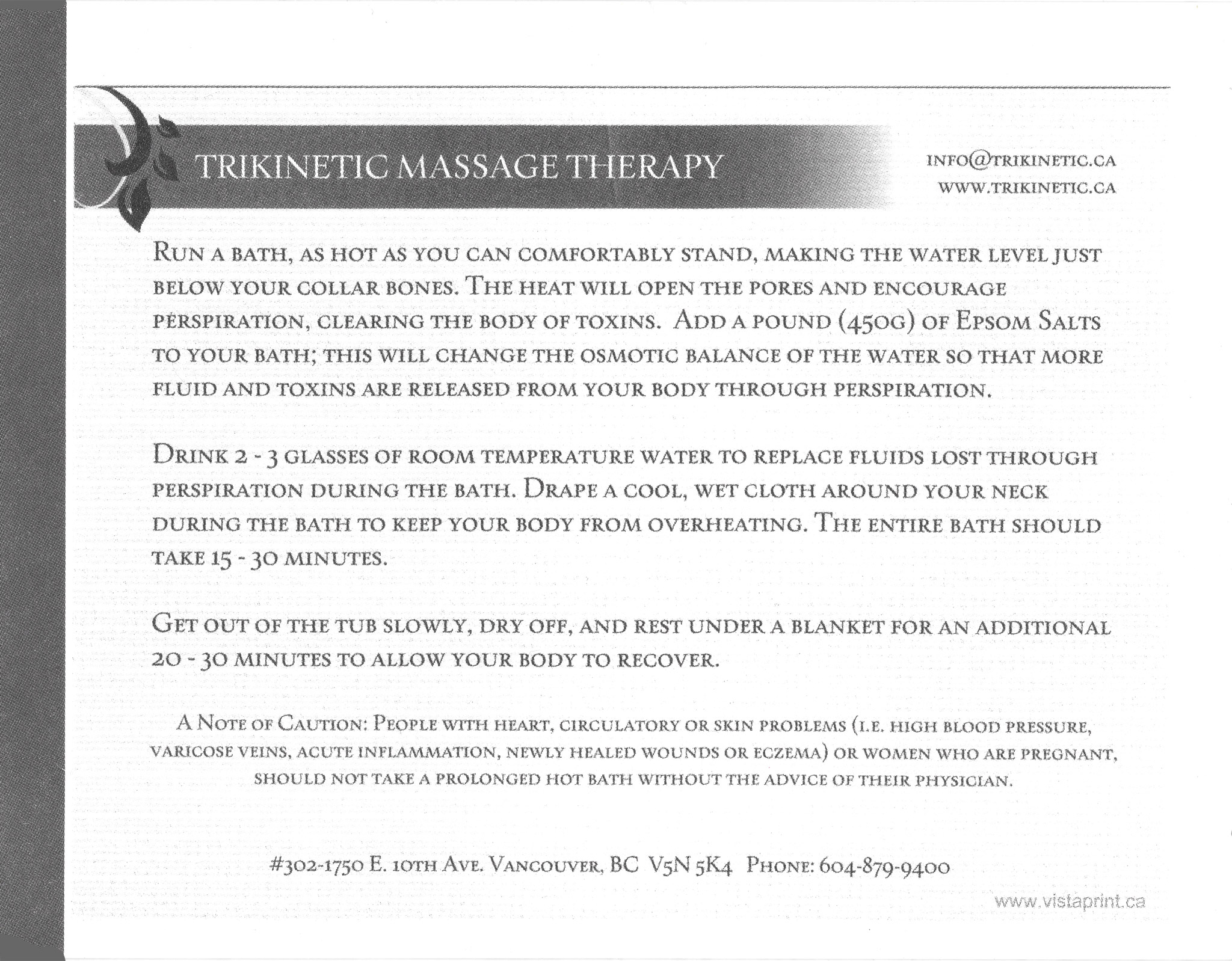
Muscle Energy Technique
Muscle Energy Technique (or MET) is one form of therapy that is derived from the study of the musculoskeletal system, called Osteopathy. The theory suggests that if a joint isn’t used to its full range of motion, its function will lessen and it will be at risk of suffering strains and injuries. The goal of MET is to lengthen shortened muscles, improved weakened ligaments, muscle strength, and range of motion. Patients will be asked to contract a muscle against a light force applied by the therapist. The muscle contraction is performed 2-3 times in a row to facilitate a stretch in the muscle with each one. This is a system of diagnosis and treatment in which the patient voluntarily moves the body as specifically directed by the therapist.This directed patient action is from a precisely controlled position, against a defined resistance by the therapist.
Myofascial Release
Myofascial Release is a safe and very effective hands-on technique that involves applying gentle sustained pressure into the Myofascia / connective tissue restrictions to eliminate pain and restore motion. Gentle pressure, applied slowly, will allow fascia/connective tissue to soften. Trauma, inflammatory responses, and/or surgical procedures create Myofascial restrictions that can produce restrictions in pain sensitive structures which do not show up on many of the standard medical tests (x-rays, MRIs, CAT scans, etc.).//br> Myofascial Release is performed directly on skin without oils or creams, this enables the therapist to accurately detect fascial restrictions and apply the appropriate amount of sustained pressure to facilitate release of the fascia. This technique is useful for almost any type of injury or physical problem. Arthritis, headaches, low back pain, tennis elbow, golfer’s elbow, swimmer’s shoulder, frozen shoulder, sciatica, strains, sprains, and whiplash injuries are just a few examples.
Neuromuscular Therapy
Neuromuscular therapy involves applying pressure to the skin with the aim of stimulating specific hypertoned areas of skeletal muscle, called trigger points. Trigger points are painful points located within taut bands of muscle, and are treated primarily with the application of sustained, usually static pressure. This can vary from very light to heavy depending on the stage of development of the trigger point. Through the softening of trigger points, NMT aims to reduce chronic pain, increase range of motion, and correct postural distortions.
Pelvic Muscle Opener
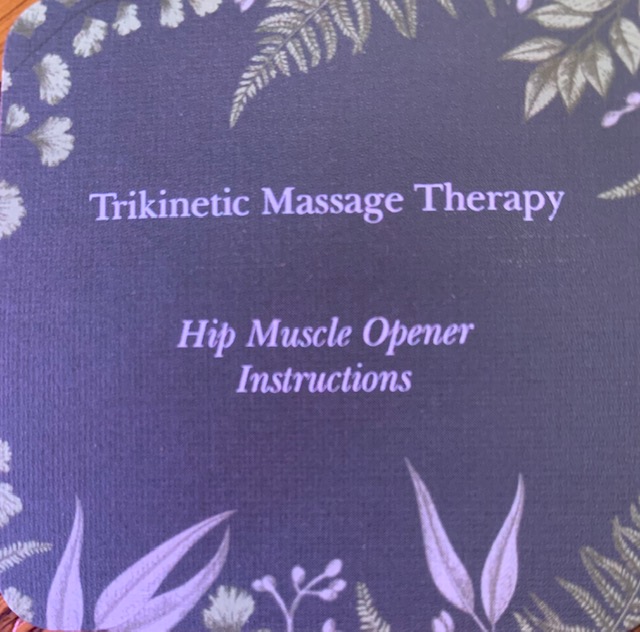
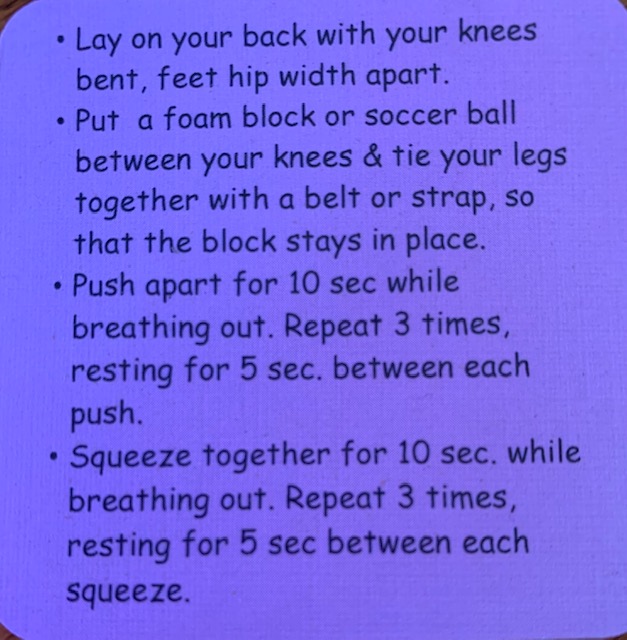
Pregnancy Massage Therapy
Pregnancy is a tumultuous period for a person’s mind and body. Anyone who has been pregnant can sympathize with the mental and physical fatigue associated with being pregnant. There are many physical & mental changes throughout the approximately 40 weeks of pregnancy. Massage has been known to calm many of the aches and pains associated with pregnancy such as sciatica, swelling, back and neck pain, and stomach upset. Pre & perinatal massage has been shown to improve physical discomforts by encouraging circulation and by releasing the muscles and joints to fuller ranges of motion. Studies show that regular prenatal massages helps create a greater sense of ease for both the pregnant person and the fetus, helping the pregnancy go more smoothly.
Stretching and Homecare
After a treatment the therapist will often recommend a variety of stretches to help maintain the effect of the treatment and increase your quality of life. These stretches are recommended specifically for you and your unique body. Some of our therapists practice Yoga and use this as a jumping off point for homecare stretches. Other homecare techniques that we recommend to patients include hydrotherapy techniques, self-care with “spiky” balls or tennis balls or golf balls, and applications of heat to allow for better stretching, and ice to reduce inflammation.
Swedish Massage
Swedish massage is the most popular and well-known form of therapy in North America, and forms the basis of all massage therapy training in BC. It consists of five basic types of stroke: effleurage, petrissage, frictions, tapotement and deep transverse frictions, which are usually applied to the body with lubricating oil or lotion. Some of the most common treatments include post-workout muscle pain, repetitive strain disorder, headaches, low back pain, stress-induced muscle pain, pregnancy issues, motor vehicle accident injuries, post-surgical recovery, fibromyalgia, multiple sclerosis and plantar fasciitis. We also treat many other types of specific, and general, pains and disorders with this technique.
Trigger Point Therapy
A myofascial trigger point is a hyperirritable spot, usually within a taut band of skeletal muscle or on the muscle’s fascia, which is painful on compression. Trigger points often give rise to characteristic referred pain, “jump signs”, point tenderness and other physical symptoms such as sweating, itchiness or tingling. Trigger point therapy applies progressively increasing pressure on a trigger point in order to eliminate the point’s tenderness. Typical applications for this technique include computer shoulder and elbow, golfer’s and tennis elbow, post-surgery wrist pain due to IV problems, arm weakness/tiredness, and sciatica. (Reference: Myofascial Pain & Dysfunction by Janet Travell, M.D. and David Simons, M.D., 1983.)
Visceral Manipulation
Visceral manipulation is the practice of an experienced therapist using their hands to move and release fascial restrictions in the abdomen and pelvis to encourage the normal movement and function of internal organs. The trunk and pelvis form a boney, muscular, fascial outer shell to protect and encase all of the internal organs. The organs are not just loosely floating around, they are mostly supported by tissue called fascia. Everything is a series of sealed systems under pressure that squishes everything tightly together; each organ is wrapped in its own fascia and bathed in a little bit of fluid so it can slide and glide over its neighbouring organs. Pregnancy, abdominal surgery, infection, jarring injuries (sports, car accidents) and emotions (stress, traums, anxiety) can all affect the mobility of the organs or viscera. . . . and will ultimately affect the ability of the body to move and function properly.
Alternative Therapies for Cancer Patients
Mesothelioma patients often explore alternative therapies alongside conventional treatments to improve their quality of life. Often patients turn to options in holistic treatments, body-based therapies, medicinal marijuana, and other alternatives to improve their well-being during recovery. The guide in the link below discusses holistic approaches such as acupuncture, osteopathic medicine, meditation, and herbal supplements, highlighting their potential benefits and how they may complement standard cancer care. Read more at Mesothelioma.net
